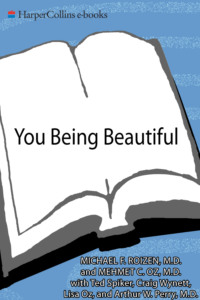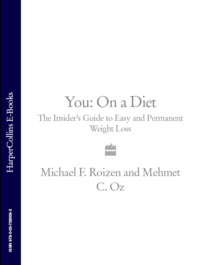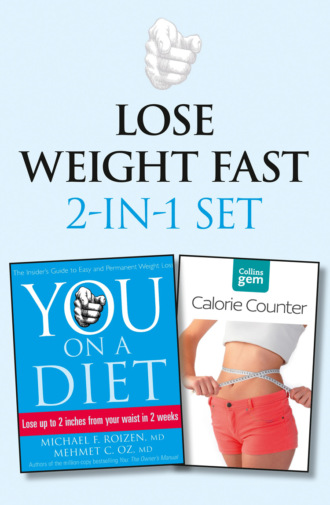
Полная версия
You: On a Diet plus Collins GEM Calorie Counter Set

You: On a Diet
and
Collins Gem Calorie Counter
Contents
Cover
Title Page
You: On A Diet
Collins GEM Calorie Counter
Copyright
About the Publisher
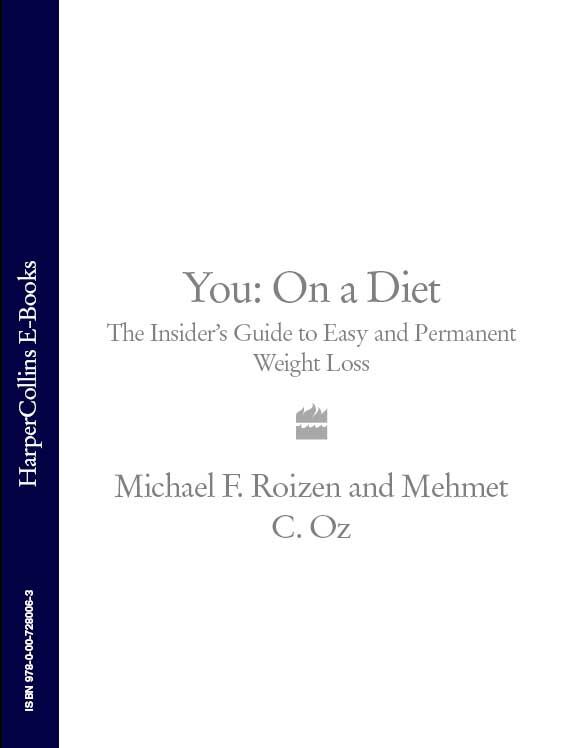

The Insider’s Guide to Easy and Permanent Weight Loss
MICHAEL F. ROIZEN, MD
MEHMET C. OZ, MD
Authors of the million-copy bestselling You: The Owners Manual
With Ted Spiker, Lisa Oz, and Craig Wynett
Illustrations by Gary Hallgren

Disclaimer
This publication contains the opinions and ideas of its authors. It is intended to provide helpful and informative material on the subjects addressed in the publication. It is sold with the understanding that the authors and publisher are not engaged in rendering medical, health, or any other kind of personal professional services in the book. The reader should consult his or her medical, health, or other competent professional before adopting any of the suggestions in this book or drawing inferences from it.
The authors and publisher specifically disclaim all responsibility for any liability, loss, or risk, personal or otherwise, which is incurred as a consequence, directly or indirectly, of the use and application of any of the contents of this book.
Dedication
To the millions who have dieted hard,
so they can learn to diet smart
Introduction
YOU: On a Diet
Work Smarter, Not Harder
Most diets promise commonsense solutions to tight-pants problems: Eat less, and you’ll weigh less. Keep your mouth closed, and you’ll keep the pounds off. Sweat like a sauna-dwelling sumo wrestler, and you’ll wind up skinnier than a sheet of paper. Straightforward enough. But if it really worked that way, our bodies wouldn’t be large enough to be spotted by Google Earth. If it really worked that way, then most diets wouldn’t fail. If it really worked that way, then we all must be a bunch of rebellious hellions with mayo-covered lips and belt-busting bellies who don’t feel like following a few simple instructions.
Or it could be that most diets have it all wrong.
We believe it’s the latter.
You know why? Because most diets instruct you to take on the corn chips, meatball specials, and dessert trays with brute force. It’s you versus food in a lifetime heavyweight fight. But in that scenario, the fight is always fixed—and not in your favor. That’s because the battle against extra pounds isn’t won with force, with sweat, with trying to diet. It’s won with elegance, with smarts, and with healthy choices that become as automatic as a Simon Cowell barb.
When it comes to dieting, trying to whip fat with our weapon of willpower is the food equivalent to holding your breath under water. You can do it for a while, but no matter how psyched up you get, at some point your body—your biology—forces you to the surface gasping for air. And with most diets, your body forces you to gasp (or gulp) for food. No matter how hard you try not to eat, some hidden force deep inside is always prying your mouth back open, making it impossible for willpower to win. Instead of sparring with your waistline, it’s time you made your body an ally in the fight against fat.

Our process is to look at our overweight bodies the way scientists would: Identify the underlying biology of the problem, then find the cures. Why? Because we’re lucky enough to be in the right place at the right time—a time when the scientific world has just now started to unlock the biological mysteries that have caused us to store fat and gain weight. For the first time in our history, the scientific community is uncovering the medical evidence about food, appetite, and satiety that will allow you to tackle weight problems with the real weapon against fat: knowledge. By making this knowledge simple and accessible, we’re going to give you tools and actions to crack the code of true and lifelong waist management. In fact, our plan will help you avoid the dangerous yo-yo cycle of weight gain and weight loss. We’re going to help you reprogram your body so that you can keep off the weight you lose forever.
Through the years, many of us have been led to believe that our weight problem is about two things: calorie counting and mental toughness. While some of us may say that the weight problem is too much of the twelve-cheese lasagna, the real problem is that most of us have as much of a clue about how our bodies work as we have about how our cars do. Sure, we know the major parts and generally what they’re supposed to do. The real danger of thinking we have most of the answers is that we stop asking the questions. If we look under our hood, do we really understand the systems that make our bodies accelerate to a life of fat and the ones that slam the brake on the dangerous cookie-and-cake collisions that take place every day? Probably not, and that’s what we’re here to help you learn.
Above all, we’re going to teach you that when it comes to dieting, you need to work smart, not hard.
Following our plan, you can expect to drop up to two inches from your waist (or a dress size) within two weeks and see results steadily after that. While the end goal is what many of us look for, we believe that the path you choose to get there is what really dictates whether you make it or not. Our path looks like this:
Part 1: What a Waist! Starting here, we’ll talk about our major principles for how the body is designed to work and how our program is geared toward those functions. And we’ll also give you the biological ideals of the human body—how our bodies originally looked and functioned. We’ll also give you some self-assessment tools for figuring out your own body’s ideals. Once you know where you’re going, you’ll have a better idea of how to get there.
Part 2: The Biology of Fat. Here you’ll follow morsels of food from the pantry to the porcelain bowl and everywhere in between. We’ll start by exploring the physiology of appetite, and then we’ll dive into the science of fat—how we store it, how we burn it, how we fight it. You’ll learn what a truly amazing system your body is when you steer it in the right direction through wise nutritional and activity choices.
Part 3: The Science of the Mind. When it comes to overeating, most of us put more emphasis on what we’re noshing than on what we’re thinking. But you can’t discuss weight issues without exploring the scientific and chemical (and even spiritual) reasons why your brain hormones and your emotions drive you to the eight-enchilada special. More important, we’ll show you the strategies for making your emotions and the chemicals that drive them work for, not against, your waistline.
Part 4: The YOU Diet and Activity Plan. After you read and learn about the intricacies of your body, you’ll find the eating and activity plan that will teach your body to eat and work smart. Your body will become your gym as you gain sleek strength in your body’s foundation muscles—all without using weights. And you’ll learn to make the right decisions in the supermarket aisle and at the fast-food window. The fourteen-day plan outlines recipes, exercises, and actions you can take to live leaner and healthier.
(In our appendices, we’ll explore the medical options for dealing with weight issues—for times when you may plateau, and for those people whose weight problems have led to major medical problems.)
Now, with all the diet information that’s circulating today, sometimes it’s hard to know what’s right, and sometimes it’s hard to remember what to do even if it is. That’s why we feel that while the program is important, how you learn it—how you ingrain it as part of your lifestyle—is just as vital. As we travel through the four parts of the book, you’ll notice various ways you’ll learn about your body and how to change it. These are the five main elements we’ll use along the way:

YOU-REKA IMP
YOU-reka Moments! Like Einstein suddenly realizing that E = mc2 you’ll develop deep insights that challenge your preconceptions about diets, about fat, and about your body. In the margin, you’ll see our YOU-reka imp—the signal that we’re about to come upon a moment of enlightenment by busting a myth or explaining something to you about diets that may seem 180 degrees from what you believe is true.
YOUR Body: In parts 2 and 3, as we explore the biology of your body, we’ll start each chapter by giving quick biology lessons about what really happens inside your body. We ask that you put on your metaphorical scrubs and gloves as you whiz through your arteries, travel through your intestines, and hang out in your stomach. We’ll get up close to your fat so we can see how your body handles it and how it manipulates your body. We believe that by learning about how the inside of your body works, you’ll develop the smarts you need to change how the outside looks.
YOU Tests. Through interactive quizzes and measurements, you’ll establish baselines for such vital statistics as your ideal body size and your eating personality. And you’ll also be able to test for the secret things that could be contributing to a weight problem (get a load of our tongue test on page 70). You can start in a few pages by taking the Fat Facts Test on page 17.
YOU Tips: After we explore the biology of your body to show you what bad things can happen if you make the wrong choice or have cross-wired genetics, we’ll immediately give you actions that can help turn your body around. At the end of each chapter, we’ll outline intelligent strategies—big and small—for living, eating, and moving in a more healthful way.
The YOU Diet and Activity Plan: In Part 4 (on page 191) we’ll detail the specific and simple strategies, recipes, and exercises that will lead you to the body you want—for the rest of your life. The fourteen-day YOU Diet (it’s actually so easy that we crafted a seven-day plan that you do twice) and the no-weights-required YOU Workout provide all the tools and instructions you’ll need. Best of all, they don’t take a lot of time, and they’re so easy that you can incorporate them into your life today.
So where do we start? With our first YOU-reka! moment: Your body naturally wants to take you to your optimum weight, as long as you don’t get in its way.

That’s right. For almost everyone, no matter what your genetics, the systems, organs, and processes of your body all want you to function at an ideal weight and size. With the following few principles that we’ll develop throughout the book, we’re going to teach you how you can make that happen without having to bludgeon yourself in frustration with a butter knife. These are our major principles of achieving your very best and very healthiest body.
YOU Will Choose Elegance over Force
Most dieters try to defeat their Oreo/Cheeze Doodle/custard pie infatuations with will, with deprivation, with sweat, with a “my-brain-is-stronger-than-your-crust” attitude. But trying to beat your body with mind power alone may be more painful than passing a melon-size kidney stone. Instead, you have to learn about the systems and actions that influence hunger, satiety, fat storing, and fat burning to fine-tune your corporeal vehicle so it runs on autopilot and takes you to your ultimate destination: a healthy, ideal body. (For those who want to skip ahead, you’ve probably already peeked at Part 4; however, getting to know the nuances of your body is what will help you achieve and maintain a truly healthy-size body.)
FACTOID
When you lose weight without exercise, you lose both muscle and fat, but when you gain weight without exercise, you gain only fat. It’s much easier to gain fat weight than it is to gain muscle weight which is one of the reasons why yo-yo dieting fails so miserably: When you continually gain and lose and gain and lose, you end up gaining proportionally even more fat, because of the muscle loss that takes place every time you lose.
YOU Will Learn How Your Body Thinks
True body improvement is about science. It’s about making the leap from witchcraft to hard data, from alchemy to chemistry, from speculation about what works for your body to explanations of how your body actually works. The only way you’ll understand the way calories and fat travel from that 2,000-calorie onion loaf to the back of your arm is by bringing alive the physiology of hormones, blood, organs, and muscles—by explaining the processes of digestion, starvation, fat storage, and muscle movements. When you understand the magic of physiology and the fun of biology, you’ll know what actions to take—and why you’re taking them—to reboot your body back to where it wants to be. Just as when you’re trying to help a tantruming toddler or kick-start a frozen computer, you can’t fix it unless you know what’s wrong. Know the why, and it’s much easier to handle the how—when you need to. Let’s face it, we’re not going to be sitting next to you at 10:30 p.m. when you’re pilfering a Pop-Tart. So you need to be equipped with knowledge of how your body works and reacts to that Pop-Tart so that you can defend against the little sugar-coated bugger.
YOU Will Challenge Your Beliefs about Diets
Throughout our lives, we’ve been conditioned to believe that if one thing is good for us, then more of it must be better. If you eliminate 100 calories from your daily diet, then eliminating 400 must qualify you for size 2. If you walk to lose weight, then running a marathon must nuke the fat right off your body. Well, neither idea is true. Worse, not only aren’t they true, but many of the diet myths perpetuated today actually hurt our bodies. Food deprivation, for example, drops your metabolism and makes your body want to store fat. Many of the rules, ideas, and principles you may believe about dieting—that you assume work when dieting—simply aren’t true and can very well contribute to weight issues because they keep the vicious cycle of fat loss and fat gain revolving faster than Lance Armstrong’s front wheel.
FACTOID
In men, the supplement L-carnitine-at a dose of 3 grams a day-helps muscles use carbohydrates, but it is also good for blood vessel function in both men and women.
In a way, we live on the two extremes of a pendulum. Either we swing all the way in one direction (strict, tedious dieting with a draconian low daily calorie intake), or we swing all the way in the other direction (popping cream-cheese-smothered bagels like grapes). We have to stop swinging so much and start living in the middle of that pendulum by striking a balance and avoiding the periods of extreme “ons” and “offs.”
One of the reasons why most so-called diets fail is because of a psychological and behavioral flaw that many dieters have. We desperately want to believe the simple, comforting promises that diets make—that doing A always gets us B. Because once we see that A (eating wheat germ 24–7) doesn’t always equal B (the cover of Vogue), then we get frustrated and angry, and give in to the gods of cream-filled baked goods.
Unfortunately, your body and your fat do not have a linear, two-step relationship. Instead, think of your body as an orchestra. All of its systems, organs, muscles, cells, fluids, hormones, and chemicals play different instruments, make different sounds (your intestines have dibs on first-chair tuba), and produce different results depending on how you use them. They work independently, but only when they’re played together can you appreciate the magnificent symphony of your own biology. As the conductor of your biological orchestra, you control how the instruments interact and what the final result will be.
YOU Will Make Dieting Automatic
While we want you to “not think” about eating good foods, we also know that “not thinking” may be how you got into this pants-stretching mess in the first place. When you don’t think about the consequences of ordering football-size cal-zones, you wind up with such pleasantries as high LDL (lousy type of) cholesterol, low HDL (healthy type of) cholesterol, inflammation in your arteries, and a higher risk of aging arteries that cause memory loss, heart disease, even wrinkles, as well as a steady stream of coupon offers from the large men’s department. We want your body to guide you to the right choices—without thinking about them—so that they’ll lead to the results you want. It will take some effort at the start to retrain your habits, palate, and muscles, but this program will serve as a lifelong eating, activity, and behavior plan that will become as routine as going to the bathroom before bed.
Unless you’re the rare kind of person who responds to dietary drill sergeants, you won’t find long-term solutions using traditional weight-loss methods: willpower, deprivation, fads, phases, or dead-bolting the lid of the butter pecan. Instead, using this plan, you will train yourself to never think about how much you’re eating, never think about getting on a diet or worry about coming off one, and never have to figure out formulas, zones, or, for the love of (fill in the deity of your choice), place a chicken breast on a food scale.
YOU Will Focus on Waist Management
Our society seems almost as obsessed with pounds as it is with celebrity breakups, but it’s time to shift your thinking: Studies have shown that waist circumference, not overall weight, is the most important indicator of mortality related to being overweight. Of course you’ll lose pounds on this plan, but we want you to switch your focus from a number that measures your weight to one that measures your waist. Because of its proximity to your organs, your belly fat is the most dangerous fat you can carry.
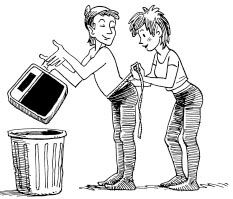
YOU Test
Take Out the Tape
Some people haven’t stepped on a scale since Laverne & Shirley played prime time. And that’s a good thing. For our purposes, you don’t need to know how much you weigh (but if you want to check your progress on this program, then go ahead and peek). All you need is a tape measure. Measure the circumference of your waist at the point of your belly button, and record the score here. (Depending on how your weight is distributed, you may need to make an adjustment to where you place the tape. If you’re obese, keep the tape measure parallel to the floor during measurement.)
YOUR SIZE:
For optimum health, the ideal waist size for women is 32½ inches; once you hit 37 inches, the dangers to your health increase. For men, the ideal is 35 inches, and the dangers to your health increase once you hit 40 inches.
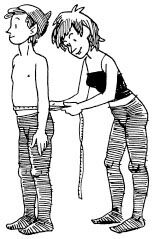
While we’re going to emphasize waist over weight in this book, we also know that many of you won’t be able to resist the siren of the scale. When it comes to actual weight, you do need to stop thinking about one specific number. (“I want to get down to one hundred thirty.”) All of us have an ideal playing weight-not a weight for running marathons or making All Pro linebacker or posing for an airbrushed-anyway centerfold. This ideal playing weight is a range in which you live lean and healthy, and one in which you significantly reduce the risks of aging diseases associated with being overweight (more on all of this in Part 2).
In addition to helping you shrink your waist through diet, well also teach you the exercises that will help you achieve and maintain a healthy waist size. Now, we don’t want you to think that exercise must involve sweating like a waterfall and panting like an obscene caller, because it doesn’t. But you do need to start thinking about your body as a dartboard: it’s all about what’s in the center. You’ll be focusing on the physical activities that will help control your waist size—specifically walking and foundation-muscle training of your entire body (without growing igloo-size muscles). Well teach you simple moves that will develop all of your foundation muscles, and well teach you how to tighten your belly, improve your posture, and develop the muscles that will make you fit into your clothes better. That translates into a shapelier waist, which, studies show, makes you more attractive to others.
But let’s not overlook the management part of the waist management equation. We all know how good managers work: they plan ahead and create systems that play to people’s strengths, they set realistic goals, they measure progress, and they don’t force their employees down roads that are designed to give them a pack-your-things meeting with HR. You need to train yourself to be a good waist manager by following a plan that’s designed to help you become the CEO of your body.
You Will Focus on YOU, but Not Rely on YOU
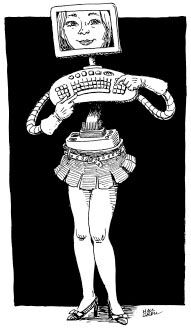
It doesn’t matter whether you look at presidents (Lincoln or Taft), musicians (Usher or Heavy D), or tennis players (Sharapova or Serena), it’s clear that we all have different builds, just as we all have different genetics, metabolic rates, and chemical interactions. Still, there are some fundamental biological facts that are true whether you’re built like a branch or a stump. As a species, we’re programmed to gain and preserve the right amount of weight. That’s simply what our bodies are designed to do (more on that coming up). The trick is to figure out your factory settings. Then, we’ll give you the all-important lock-setting tools that will help you to reboot those factory settings so that your body maintains its ideal size and shape.
While this is a very individual challenge, it doesn’t have to be a lonely one. Life is a team game; you’ve got sports teams and surgical teams, restaurant staffs and office staffs, hip-hop clubs and calculator clubs. And of course you have the ultimate team: your family. The most successful teams all work the same way: Everybody plays a different role and contributes in his or her own way. You may have a Shaq, Kobe, or LeBron on your team, but the team can’t win the title unless everybody, not just the stars, works for the team goal.
Somehow, though, when it comes to weight control, you believe that you’re solely responsible for dropping your excess pounds and changing your habits. To make it worse, when you’re gaining weight, even the fans are chipping in on your side; the world around us wants us to gain weight in the form of big portions, drive-throughs, and family dinners that could feed a small municipality. Then when you’re trying to lose weight, it’s as if everyone’s against you; they bring junk food into the home, suggest that everyone goes out for ice cream, and feast on pork fat while you’re trying to gnaw on cauliflower.


